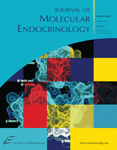| HOME | HELP | CONTACT US | SUBSCRIPTIONS | ARCHIVE | SEARCH | TABLE OF CONTENTS |
|
|
||||||||
REVIEW |
Department of Medicine, University of Melbourne, Austin Health, Heidelberg, Victoria 3084, Australia
(Requests for offprints should be addressed to Helen E MacLean; Email: hmaclean{at}unimelb.edu.au)
Androgen treatment can enhance the size and strength of muscle. However, the mechanisms of androgen action in skeletal muscle are poorly understood. This review discusses potential mechanisms by which androgens regulate satellite cell activation and function. Studies have demonstrated that androgen administration increases satellite cell numbers in animals and humans in a dose–dependent manner. Moreover, androgens increase androgen receptor levels in satellite cells. In vitro, the results are contradictory as to whether androgens regulate satellite cell proliferation or differentiation. IGF-I is one major target of androgen action in satellite cells. In addition, the possibility of non-genomic actions of androgens on satellite cells is discussed. In summary, this review focuses on exploring potential mechanisms through which androgens regulate satellite cells, by analyzing developments from research in this area.
This article has been cited by other articles:
 |
J. Svensson, S. Moverare-Skrtic, S. Windahl, C. Swanson, and K. Sjogren Stimulation of both estrogen and androgen receptors maintains skeletal muscle mass in gonadectomized male mice but mainly via different pathways J. Mol. Endocrinol., July 1, 2010; 45(1): 45 - 57. [Abstract] [Full Text] [PDF] |
||||
 |
H. E. MacLean, A. J. Moore, S. A. Sastra, H. A. Morris, A. Ghasem-Zadeh, K. Rana, A.-M. Axell, A. J. Notini, D. J. Handelsman, E. Seeman, et al. DNA-binding-dependent androgen receptor signaling contributes to gender differences and has physiological actions in males and females J. Endocrinol., July 1, 2010; 206(1): 93 - 103. [Abstract] [Full Text] [PDF] |
||||
 |
M. M. Hamdi and G. Mutungi Dihydrotestosterone activates the MAPK pathway and modulates maximum isometric force through the EGF receptor in isolated intact mouse skeletal muscle fibres J. Physiol., February 1, 2010; 588(3): 511 - 525. [Abstract] [Full Text] [PDF] |
||||
 |
M. A Gentile, P. V Nantermet, R. L Vogel, R. Phillips, D. Holder, P. Hodor, C. Cheng, H. Dai, L. P Freedman, and W. J Ray Androgen-mediated improvement of body composition and muscle function involves a novel early transcriptional program including IGF1, mechano growth factor, and induction of {beta}-catenin J. Mol. Endocrinol., January 1, 2010; 44(1): 55 - 73. [Abstract] [Full Text] [PDF] |
||||
 |
N. Preisler, G. Andersen, F. Thogersen, C. Crone, T. D. Jeppesen, F. Wibrand, and J. Vissing Effect of aerobic training in patients with spinal and bulbar muscular atrophy (Kennedy disease) Neurology, January 27, 2009; 72(4): 317 - 323. [Abstract] [Full Text] [PDF] |
||||
 |
Y Liu, M Heinichen, K Wirth, D Schmidtbleicher, and J M Steinacker Response of growth and myogenic factors in human skeletal muscle to strength training Br. J. Sports Med., December 1, 2008; 42(12): 989 - 993. [Abstract] [Full Text] [PDF] |
||||
 |
H. E. MacLean, W. S. M. Chiu, A. J. Notini, A.-M. Axell, R. A. Davey, J. F. McManus, C. Ma, D. R. Plant, G. S. Lynch, and J. D. Zajac Impaired skeletal muscle development and function in male, but not female, genomic androgen receptor knockout mice FASEB J, August 1, 2008; 22(8): 2676 - 2689. [Abstract] [Full Text] [PDF] |
||||
 |
P Diel, D Baadners, K Schlupmann, M Velders, and J P Schwarz C2C12 myoblastoma cell differentiation and proliferation is stimulated by androgens and associated with a modulation of myostatin and Pax7 expression J. Mol. Endocrinol., May 1, 2008; 40(5): 231 - 241. [Abstract] [Full Text] [PDF] |
||||
 |
A M Solomon and P M G Bouloux Modifying muscle mass - the endocrine perspective. J. Endocrinol., November 1, 2006; 191(2): 349 - 360. [Abstract] [Full Text] [PDF] |
||||
 |
A.-M. Axell, H. E. MacLean, D. R. Plant, L. J. Harcourt, J. A. Davis, M. Jimenez, D. J. Handelsman, G. S. Lynch, and J. D. Zajac Continuous testosterone administration prevents skeletal muscle atrophy and enhances resistance to fatigue in orchidectomized male mice Am J Physiol Endocrinol Metab, September 1, 2006; 291(3): E506 - E516. [Abstract] [Full Text] [PDF] |
||||
| HOME | HELP | CONTACT US | SUBSCRIPTIONS | ARCHIVE | SEARCH | TABLE OF CONTENTS |